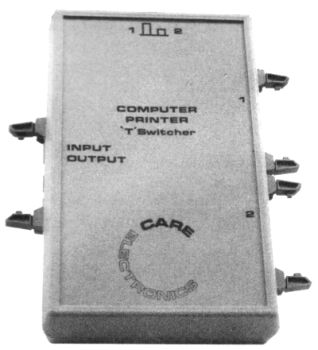| Hardware World |

IF YOU ARE someone who is forever plugging and unplugging things into your computer you will probably be aware of how quickly plugs and sockets can wear out. Usually the thing to do is to use some form of switching device, but those tend to be horrendously expensive.
Care Electronics has released a two-way printer switcher for the modest sum of £32.20 plus £2.00 p&p. It can be used to connect two computers to one printer, or vice versa.
Although originally designed for the BBC, it works well with Spectrum printer interfaces, but we found that it refuses to operate with either the Medic or Technology Research QL interfaces. As so many combinations of computers and printers are possible you would have to experiment with your own equipment.
Care Electronics Ltd, Hertfordshire.
THE NEW Kempston disc interface, a development of the Watford SPDOS, is one of the fastest interfaces we have seen for the Spectrum and it has some useful features.
Reliability proved to be a problem as the interface refused to work with either our own drives - used on all other Spectrum disc interfaces - or the Opus drive. That problem was eventually identified after trying three interfaces, and subsequent units should not suffer the same fate. If possible, either check with your own drive or buy the combined interface/disc drive package from Kempston. The interface was subjected to one of the longest tests we have ever given and it passed with flying colours.
At its simplest level, you can use the interface as you would a tape deck, to load or save a Basic program, Code or Data. You use the same commands as you would for tape but precede them by PRINT £4.
One useful by-product of the system is that you can open channel three to a file on the disc. That means as this channel normally points to the ZX Printer, you can LPRINT to the disc and then later print out the file.
As well as Format, to initialise the disc, the usual Cat (display what is on the disc), Erase (delete a file from the disc) and Move (a file from one disc to another) are provided. They allow the use of wild-cards.
The interface has a number of extensions to Sinclair Basic. Clear can be used in two ways: Clear 0 will look through a Basic program and change all numbers to VAL"number", which saves three bytes per number. It also changes zero to NOT PI, one to SGN PI and three to INT PI which saves five bytes a time. On Tasword that saves about 1200 bytes, more than enough to offset the 703 bytes taken up by the interface.
The Kempston interface provides a fast and usable system. Provided Kempston can ensure the interface will work with a wide range of drives it should do well.
The interface alone costs £85, and a system including a 40-track drive is £185, both inclusive. It is not compatible with Interface 1.
Kempston MicroElectronics, Bedfordshire.
STAR HAS launched two new printer ranges, which, at the bottom end of the range, offer exceptional features at a reasonable price.
The SG10 is an 80 column 120 characters per second printer with a built-in 2K buffer, at a recommended price of £259. The SD10 has the same features as the SG10 but runs at 160cps, and costs £389.
The SG10 uses a typewriter ribbon and has an adequate printing mechanism. The SD10 uses a ribbon cassette and is capable of very good quality print.
What raises these printers above the standard of the Epson is the wide range of print styles produced. As well as enlarged, condensed, italic and so on, you can select near letter quality and proportional spacing. The printers are compatible with both the standard Epson and IBM commands.
On the face of it both the printers are good value, but the SG10 at £259 has the edge. The SD10 is fast but that is its only advantage over the SG10.
Star Micronics UK Ltd, London.